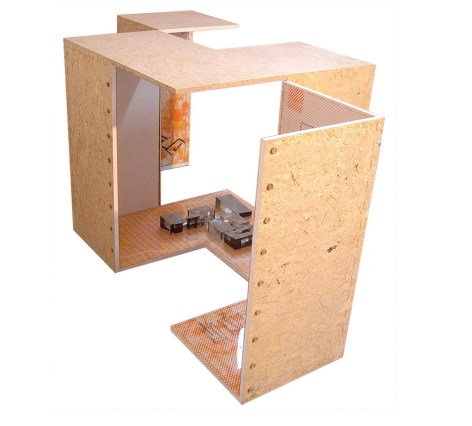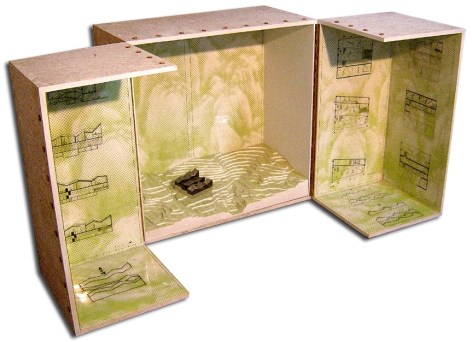Recently appointed Chair of the MIT School of Architecture, Yung Ho Chang is highly regarded both as a working architect whose projects range from single-family homes to master-plans for entire cities and as a provocative social and architectural critic. Born in Beijing in 1956, Yung Ho Chang moved to the United States in the early 1980s. After a period of teaching at Ball State University, the University of Michigan and the University of Berkeley, Yung Ho Chang opened the Atelier Feichang Jianzhu (Atelier FCJZ) in 1993, the first private architectural practice in China.
His first projects in Beijing such as the Xishu Bookstore (1996-2000) and the Upside Down Office for Cummings Asia Headquarters were small but notable for their inventiveness and wit. Another project that has attracted international attention is the Split House, 2002 which was designed for a single family as part of the Commune on the Great Wall. Despairing at the rapidity with which the urban fabric of China has been destroyed and the dysfunctional cities that have emerged from their ruins, Yung Ho Chang has proposed an urbanism that respects the complexity and rich texture of urban life. Buildings like the Morningside Center of Mathematics, Chinese Academy of Sciences, 1998, in Beijing recreate this experience within the confines of a relatively small, compact building. More recently he has turned his attention to the solution of problems presented by the devastation of the landscape by greedy developers as in his proposed Bamboo Sea-Castle-Towns in Liusha, Nanning, 2002. In this case he aims to restore the land to life by the extensive planting of bamboo and the sequential building of related structures over a period of years.
Yung Ho Chang has a wide range of interests, not least of which is the visual arts. He has designed a Small Museum of Contemporary Art (SMOCA) for the artist Cai Guo-Qiang and has designed the installation of major exhibitions such as Cities on the Move (Vienna, 1997 and Louisiana Museum, 1999). Most recently he has been selected as one of the artists representing China for the 2005 Venice Biennale. His bamboo structure will serve as the Chinese Pavilion. A video of the entire process will be shown at Chambers Fine Art during the exhibition, converting the gallery into a satellite of the Chinese Pavilion in Venice.
Yung Ho Chang is also particularly interested in disseminating his ideas in non-architectural contexts. The present exhibition consists of six boxes containing architectural design projects of Atelier FCJZ in the form of models and drawings. Among the six projects are the Villa Shizilin, Beijing (built) and Club by the Canal, Beijing (design stage). As described by Yung Ho Chang : "All the designs embrace a notion of Micro-Urbanism, which perceives urbanity as a set of relationships - spatial, physical, social, political, economical, and cultural - and attempts to establish such relationships within individual buildings." The six cubic boxes are first used as containers for international transportation. Each box opens in a different way so that "the basic tectonic form becomes a unique theater for the display of architectural ideas."
*Catalogue Available
前波画廊非常荣幸能邀请到世界着名建筑师张永和,在6月4日举办《盒子──张永和近作》的展览。张永和刚被聘为为麻省理工大学建筑系主任。作为建筑师,他不仅热切关注从私人住宅到城市规划等各种规模的工程设计,同时也是对社会与建筑的评论家。他1956年出生于北京,80年代初移居美国。在鲍尔州立大学(Ball State University),密西根大学和博克立大学工作了一段时间后,张永和1993在中国建立了第一家私人实践建筑工作室,非常建筑(FCJZ)工作室。
张永和在北京的第一批项目,比如《席殊书屋》(1996-2000) ,以及为康明斯公司亚洲总部所设计的《颠倒办公室》,虽然规模小,但设计新颖。为“长城脚下的公社”所设计的《土宅》(2002)更得到了国际瞩目。中国城市正在经历剧烈改造,毁坏了许多基本构造。张永和提倡尊重城市复杂性和多样性结构的态度。比如他为中国科学院所设计的晨兴数学中心(1998)就是一个例子,在北京重新建起相对小型,结构紧密的楼房。近期,他的注意力转移到在南宁柳沙半岛上被开发者摧毁的竹林,并提出“ 竹海三城 "的方案,以寻找解决的方法。在这个方案中,他瞄准在一段时期内大量种植竹子和陆续栽种的相互关系,希望恢复土地原有的生命。
张永和对视觉艺术也具有厚厚的兴趣。他参加了蔡国强策划的当代美术展(SMOCA),及在路易安娜博物馆举行的《运动中的城市》的展览。最近,他被选为2005年威尼斯双年展中国参展艺术家之一。他将搭建一个以竹子为材料的建筑。前波画廊在《盒子──张永和近作》展览的同时,会展出搭建这个竹子建筑的录像,将前波画廊变成威尼斯双年展中国馆在纽约的卫星展场。
张永和的兴趣不仅仅局限于建筑。前波画廊这次所展出的六个盒子内置有建筑设计方案的模型与制图。张永和这样描述这六个盒子的设计观念:“所有的设计包含着与微型城市化相关的概念──空间性,天然性,社会性,政治性,经济性与文化性相结合并尝试将这些关系建立为一体。”这六个立体盒子首先被用作为运输国际商品的集装箱。每个盒子打开的方式都不同,所以“最基本的构造形势变为了建筑观念的独特展览舞台。”
*前波画廊为此展览出版了展览图录



